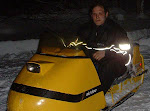whoops. It turns out my old trailer is pretty rotten underneath. The frame the springs attach to is solid but the pieces that span between that and the side rails are all bad.
You can see in this pic that the previous owner had done some repairs with pieces of angle iron in the past.
I'm debating if I replace this trailer or buy some steel and rebuild it. I'm pretty much 50/50. Ben has an enclosed trailer he's talking about selling. I'd been talking about an enclosed trailer anyway, it would keep my nicer sleds from degrading over the summer like they tend to do when left under tarps so that would be a good option. On the other hand if the only thing this trailer needs is three or four pieces of steel I'd be a fool not to replace them. At the very least it would make the trailer valuable enough to sell or take to camp where we could use it as a utility trailer. For now I won't be taking it very far from home.
Anyway I welded a strip of steel from the angle iron to the side rail and then welded the light mount to that. Its not terrific but it'll get me through the rest of this season.
With that done I spent some time welding up the pipe for the Ski-Doo. When I was riding Saturday it popped and got louder. I found a bunch of pinholes in the main pipe, mostly around places I'd welded before. That pipe is looking like the Frankenstein monster. I cleaned up those welds and added some filler. I also fixed a spring hook that had broken. I need to finish out by pulling the last part of the can and rebuilding its flange to the next piece up stream. I managed to do a similar repair on another piece that came out nice. If nothing else this kind of work helps me become a better welder.
















